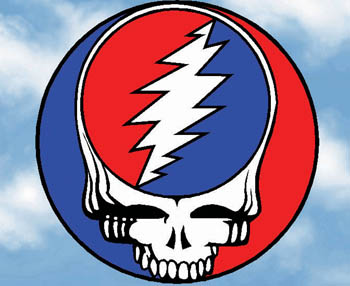![[Metroactive Features]](http://metroactive.com/features/gifs/feat468.gif)
[ Features Index | Silicon Valley | Metroactive Home | Archives ]
Grateful He's Dead
If the car is an extension of you, maybe some Deadheads were catching on that the police could easily profile them based on wacky cars and stickers and make the assumption: possession of narcotics
By Novella Carpenter
THERE WE WERE, standing outside of the Henry Kaiser auditorium in Oakland. "Do you know how amazing it is for me to be here?" Phil asked, his curly red hair flapping in the night wind. "No." There was a homeless man sleeping under the gigantic light fixtures near the massive doors. We were standing on the lawn. Phil had insisted we pull over, that I honor his nostalgia.
"OK—imagine it, this whole lawn, this entire building, the road here: filled—teeming—with Deadheads." "Gross," I said, offending Phil, a Deadhead since 1985, before the band hit big with "Touch of Gray," and all the frat guys started showing up for shows. But I can say that to Phil, because he can take it, and he understands that I don't understand. "No, no, no—it was great! People reuniting from the last show, playing hackeysack, selling stuff from Central America out of the back of the car. ..." Phil got a maniacal look on his face. "Hey, you should write a column about Deadheads and their cars!"
Hmmm, I would explore their culture, their nomadic lifestyle, their love of parking lots in order to get to the bottom of the question: Why do so many people follow the Dead? I've been waiting for the 10th anniversary of Jerry Garcia's death (Aug. 9) to come along first, so that I could celebrate—I mean commemorate—the passing of Jerry with a column. So, let's "get on the bus."
I pieced together that Neal Cassady and Ken Kesey's Merry Prankster bus started it all. A 1939 International Harvester school bus with "Furthur" [sic] on the destination placard, Cassady at the wheel and a sign reading, "Caution: Weird Load" on the back initiated members of the Dead into their subculture. According to Dennis McNally's A Long Strange Trip, "Neal's practice was car driving. Cassady could see around corners and take his car through spaces that didn't exist." Garcia and friends "got on the bus," and this phrase spanned time to mean, eventually, that you crossed over to become a Deadhead.
The prototypical Dead car is the VW bus, which a writer for Car and Driver called the ultimate "negative status symbol: plain as a brick, simple as a lawn mower, slow as glue, cheap to buy, cheap to run and cheap to fix." Despite some clues, Deadhead jargon and iconography still confused me. Then I found a sociological study called Deadhead Social Science. Written by graduate and Ph.D. students who observed the Deadheads in their natural elements, it gave me the details I needed to know:
"The parking lot always steadily filled with cars, buses, trucks, and vans from just about every state in the country. 1965 VW with Day-Glo paint and 56 stickers alerting readers and passersby to the driver's penchant for liberal politics and Grateful Dead music. Others were more difficult to spot: a mainstream vehicle, maybe with a small sticker or two on the rear windows. Other drivers posted no such statement of identity."
If the car is an extension of you, maybe some Deadheads were catching on that the police could easily profile them based on wacky cars and stickers, and make the assumption: possession of narcotics.
The book goes on to describe how people arrive early before the show and do some shopping on Shakedown Street, a.k.a. the parking lot. This is where all manner of crafts, drugs and vegetarian food stuff are sold or traded. The merchants are called tourheads; they sell goods to make just enough money to buy gas in order to get to the next show. The lifestyle sounds harsh—sometimes the vendors drive 300 miles in a day in order to reach the next show, only to repeat the whole thing over again. Tourheads could be considered pilgrims, sacrificing just to take part in the ritual.
By the end of my research jag, I could finally understand why people went to shows: the built-in community, respecting time's passing, enjoying life and being part of something. I'm saddened that with Jerry's death—reunion and spin-off band attempts aside—that era ended.
[ Silicon Valley | Metroactive Home | Archives ]
Copyright © 2005 Metro Publishing Inc. Metroactive is affiliated with the Boulevards Network.
For more information about the San Jose/Silicon Valley area, visit sanjose.com.
![]()

Rev
Send a letter to the editor about this story to letters@metronews.com.
From the August 10-16, 2005 issue of Metro, Silicon Valley's Weekly Newspaper.